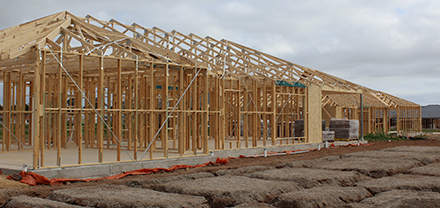Australia’s forest industries have welcomed the Federal Government’s target of one million new homes to be constructed by 2030 under the National Housing Accord announced in this week’s Federal Budget. Source: Timberbiz
But Australian Forest Products Association CEO Ross Hampton has pointed out that to build the new houses with timber Australia needed to grow supply by planting more timber production trees.
“The Government has a ‘one billion new trees’ by 2030 goal that must be achieved, otherwise Australia will be 250,000 timber house-frames short of demand by 2035,” Mr Hampton said.
“That’s the equivalent of cities the size of Newcastle and Geelong combined.”
Mr Hampton said that ensuring one million houses were built with timber would deliver a similar CO2 mitigation as taking all of NSW’s registered vehicles off the road for one-year.
“As Australia works harder to fight climate change, building new homes with sustainable, local timber is a simple and effective way to help drive down Australia’s emissions,” he said.
The construction, operation and maintenance of buildings accounts for almost a quarter of greenhouse gas emissions in Australia.
Choosing timber in new home builds meant starting with a healthy CO2 credit, as opposed to potential deficits in new dwellings built with other materials.
“Of course, to build new houses with timber we must grow supply by planting more timber production trees,” Mr Hampton said.
“Growing more trees for timber and fibre is a win, win, win. A win to fight climate change at a practical level, a win for jobs and employment in a sustainable industry, especially in our regions, and a win to build much needed supply of the most sustainable and natural building material going around,” he said.
The HIA said the one million homes target would be the first step in setting a housing benchmark that could be measured, monitored and delivered.
“Labor’s first budget shows leadership to tackle Australia’s housing supply and affordability challenges for all Australians,” said Graham Wolfe, HIA Managing Director.
“Importantly, this target provides a necessary indicator to governments at all levels, that priority action is needed should housing supply fall below 200,000 new homes each year,” Mr Wolfe said.
HIA’s forecasts showed that this situation was playing out right now – with around 196,000 new homes predicted to start in 2022 and 2023, falling to around 185,000 in 2024 and 2025.
“Year-on-year housing supply shortfalls, as we’ve seen for most of the last two decades, inevitably add pressure to Australia’s housing challenges,” he said.
“For every year that Australia doesn’t deliver enough new homes to meet demand across the housing continuum, we will see a negative impact on both housing affordability and rental affordability.”
Mr Wolfe said that the HIA had consistently advocated for the federal government to play a leadership role in achieving stable housing supply, year-on-year, in all forms and for all tenures.
“HIA welcomes the opportunity to be part of the Housing Accord and identify ways to maintain a stable level of housing supply across the housing continuum, putting housing supply front and centre,” he said.
“A structural improvement in housing affordability can only be achieved for all Australians if the supply of housing is sufficient to meet the needs of the whole community.
“The Budget commitment of $10 billion to create the Housing Australians Future Fund which aims to deliver 30,000 social and affordable rental homes, has the capacity to bridge the housing deficit. The addition of a further 10,000 affordable homes in tonight’s Budget is an important extension of this commitment.
“HIA also welcomes the Budget commitment to progress the Government’s other key housing initiatives. Housing Australia must be a central agency responsible for delivering integration of the Commonwealth’s housing policies to improve the supply of social housing, affordable rental housing and private market housing.
“HIA looks forward to the formation of the National Housing Supply and Affordability Council. The Council must steer Housing Australia in the collection and reporting of housing data that shines a light on our progress towards the target of 1 million new homes.
“The Government’s housing commitments in the Budget tonight clearly recognise HIA’s call during the federal election to make housing a national priority.”






